Ricoma Serie CHT2 Problemi comuni e soluzioni
Indipendentemente dal fatto che sia una macchina così straordinaria, puoi ancora riscontrare alcuni errori comuni riscontrati dalle macchine Ricoma. Vediamo come risolvere i problemi di ricamo Ricoma CHT2.
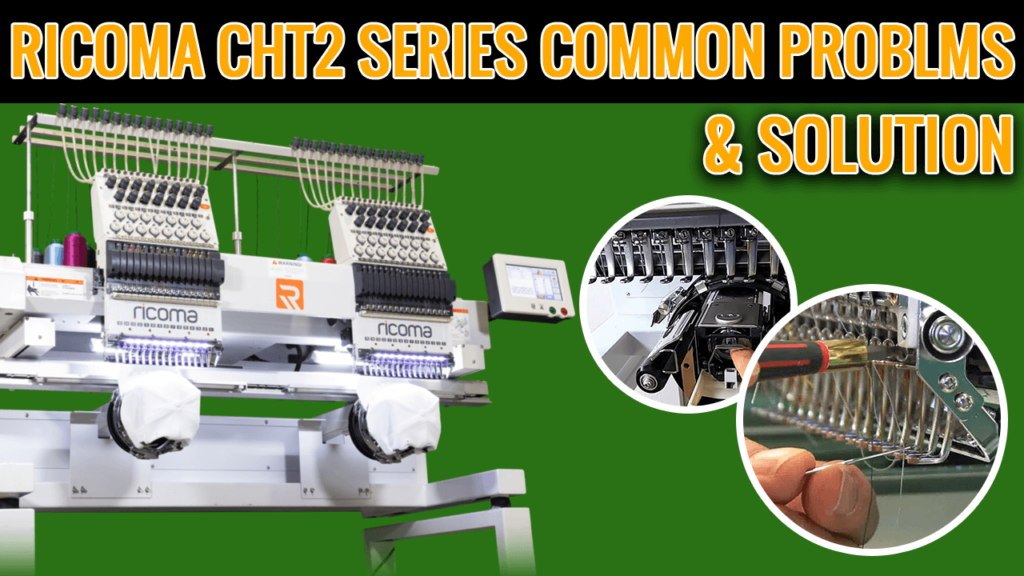
Serie Ricoma CHT2 il ricamo a macchina offre la migliore combinazione di qualità ed efficienza che ogni ricamatore desidera per far crescere la propria attività.
Serie Ricoma CHT2 è disponibile in 4 a 12 teste da ricamo. Questo ricamo a macchina accelera attraverso i piani, berretti, e ampi capi rifiniti con esattezza e accuratezza.
Ricoma CHT2 Series Common Errors &; Soluzione:
1. Perché la serie Ricoma CHT2 emette rumori?
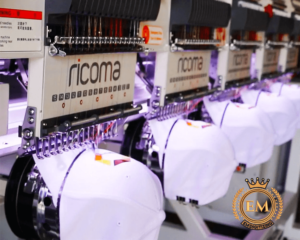
Una mancanza di lubrificazione o una lubrificazione errata possono causare rumore nella serie Ricoma CHT2. Una corretta lubrificazione è importante per mantenere la macchina in funzione in modo fluido e rapido, e può aiutare a prevenire il rumore e altri problemi.
Se tuo macchina da ricamo sta facendo rumore, una delle prime cose da fare è controllare la lubrificazione e assicurarsi che sia sufficiente e applicata correttamente.
O, puoi far funzionare la macchina per alcune ore dopo averla lubrificata per vedere se il rumore scompare o meno. Se ancora, se riscontri problemi di rumore, contatta il tuo tecnico.
2. Come eseguire la manutenzione sulla serie Ricoma CHT2?
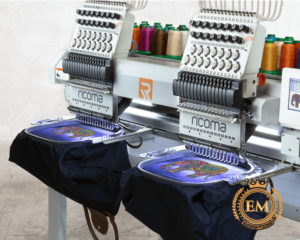
È fondamentale mantenere adeguatamente la macchina per assicurarsi che funzioni correttamente e rapidamente. Oliare la macchina ogni inizio giornata e ogni quattro ore di utilizzo costante è una parte importante di questo processo di manutenzione.
3. Come regolare la barra in velcro?
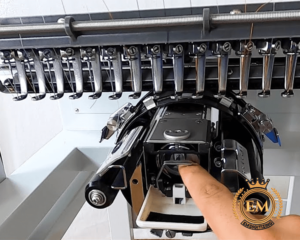
Regolare la barra in velcro sulla tua macchina non è così difficile. Seguire questi passaggi per regolare la barra in velcro:
1. Allentare le due viti sui lati sinistro e destro della testa della macchina.
2. Per centrare la barra in velcro, sposta la macchina sull'ago numero uno e assicurati che il gancio posizionato dietro la barra di velcro sia al centro della barra.
3. Ripeti la procedura sull'ago numero quindici per assicurarti che la barra di velcro sia allineata correttamente su entrambi i lati della macchina.
4. Come correggere i tempi su una serie Ricoma CHT2?
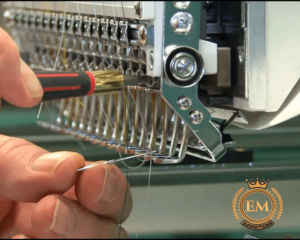
Il tempismo esatto è importante perché garantisce che la velocità dell'ago e gli altri elementi mobili del ricamo a macchina siano sincronizzati in modo che possano eseguire il tuo progetto di ricamo in modo sorprendente.
Quando il tempo è scaduto, la tua macchina può riscontrare problemi come punti saltati e disegni di punti incoerenti che possono danneggiare l'intero tessuto disegni da ricamo.
Segui questi passaggi per regolare i tempi nella tua macchina:
1. Allentare le quattro viti Phillips poste su ciascun lato del braccio per rimuovere il coperchio laterale, quindi rimuovere la placca ago svitando le due viti piatte sulla parte superiore della placca ago. Togli la custodia della bobina
2. Dopo aver rimosso la placca ago, spostare l'albero dell'asse principale spostandolo con una chiave a brugola. Ruotare in senso antiorario con una chiave a brugola sul lato sinistro del corpo 201 gradi.
Se l'ago non scende, prova a fare un altro giro completo.
3. Ora possiamo verificare se il momento è quello giusto.
Il tempismo del crochet rotante è molto anticipato
La sincronizzazione del crochet rotante è molto ritardata
Il tempismo del gancio rotante è perfetto
Se verifichi che i tempi siano corretti non è necessario eseguire la regolazione.
4. Per regolarlo dovrai allentare la prima vite a testa piatta sul lato destro del gancio rotante.
5. Ruotare la ruota dell'asse principale finché non appare la seconda vite a testa piatta e allentarla. Quindi, ruotare nuovamente l'asse principale, a meno che non appaiano l'ultima parte piatta e la vite, e allentarlo anche, tre viti in totale.
6. Ora il crochet rotante deve muoversi in modo indipendente sull'albero inferiore.
7. Ruota l'asse principale e abbassa l'ago al giusto grado di temporizzazione, ad es. 201.
8. Allinea la punta dell'uncinetto con la sciarpa dell'ago in modo che si nasconda dietro di essa.
9. Con uno spazio minimo compreso tra 0,1 mm e 0,3 mm tra il gancio e l'incavo dell'ago, tenere fermo il gancio rotante e serrare la vite di fissaggio sul lato destro.
10. Ruotare l'asse principale e stringere l'altro 2 viti a testa piatta precedentemente allentate.
11. Installare il coperchio laterale e riavvitare la placca ago in posizione.
12. Infine, prova la tua macchina!
5. Come abbassare il driver del tappo?
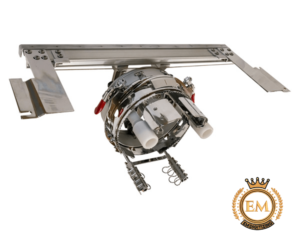
Seguire questi passaggi per abbassare il driver del tappo:
1. Posizionare e allentare le quattro viti all'interno del driver.
2. Abbassare il motore assicurandosi che non colpisca o strisci il braccio di cucitura.
6. Come risolvere un timeout di cambio colore sulla macchina?
Iniziare, assicurati che la macchina sia a cento gradi ruotando manualmente la manopola nera sull'estrema destra della macchina.
Ruotalo una o due volte per essere sicuro. Poi, verificare che tutte le leve di raccolta siano alla stessa altezza.
Se uno dei due viene saltato, puoi procedere e ripristinarlo manualmente e il problema scomparirà. Se uno di essi viene sollevato, è possibile effettuare una regolazione rapida, ovvero la "regolazione della leva di raccolta".
7. Come cancellare 257 Errori sulla serie Ricoma CHT2?
Ogni volta che ottieni un 257 errore sul pannello di controllo della macchina, significa che una delle tue teste si è annidata all'interno. Ciò significa anche che la lama non è riuscita a ritrarsi a causa dell’accumulo di filo.
Vediamo come puoi risolvere questo modello:
1. Andate verso il lato destro della macchina e verso il retro.
2. Individua il sensore cilindrico che si trova sotto la macchina (il sensore avrà 2 punte blu su due bordi ciascuna)
3. Quando si verifica un errore della taglierina, il braccio nero a destra del sensore non è allineato con la parte blu del sensore posta sul lato destro.
4. Questo braccio nero deve essere regolato. Se non puoi spostarlo, quindi rimuovi tutte le placche dell'ago e assicurati che nessun filo interrompa il percorso della lama.
5. Procedi a ruotare il braccio nero in qualsiasi direzione a meno che non riesca ad allinearlo.
6. Una volta allineato, si accenderà una luce color ambra o rossa sul lato sinistro del sensore.
7. La luce mostra che l'errore della taglierina è stato risolto.
Linea di chiusura:
Così, this was Ricoma CHT2 Series common errors &; soluzione, manutenzione ricoma chT2, e la risoluzione dei problemi della serie Ricoma CHT2. Ci auguriamo che ti sia piaciuto leggere questo articolo come abbiamo fatto noi per iscritto.
Se desideri personalizzare la digitalizzazione del logo del ricamo, EM DIGITALIZZAZIONE sarà la scelta migliore. In DIGITALIZZAZIONE EM, forniamo il miglior logo da ricamo servizi di digitalizzazione con la migliore qualità. Noi offriamo 50% di sconto su tutti i nostri servizi ai nostri potenziali clienti al loro primo ordine. Così, richiedi subito un preventivo gratuito e ci metteremo in contatto con te.
Spero che questo articolo sia utile per voi ragazzi!
Se ci sono domande relative a questo articolo, non esitare a commentarci. E, grazie per aver letto!
Puoi risolvere facilmente i problemi relativi ai rumori in ricoma. Una mancanza di lubrificazione o una lubrificazione errata possono causare rumore nella serie Ricoma CHT2. Una corretta lubrificazione è importante per mantenere la macchina in funzione in modo fluido e rapido, e può aiutare a prevenire il rumore e altri problemi.
Se la tua macchina da ricamo fa rumore, una delle prime cose da fare è controllare la lubrificazione e assicurarsi che sia sufficiente e applicata correttamente.
O, puoi far funzionare la macchina per alcune ore dopo averla lubrificata per vedere se il rumore scompare o meno. Se ancora, se riscontri problemi di rumore, contatta il tuo tecnico.
- Perché la serie Ricoma Cht2 produce rumori?
- Come eseguire la manutenzione sulla serie Ricoma Cht2?
- Come regolare la barra in velcro?
- Come correggere i tempi su una serie Ricoma Cht2?
- Come abbassare il driver del tappo?
- Come risolvere un timeout di cambio colore sulla macchina?
- Come cancellare 257 Errori sulla serie Ricoma Cht2?
1. Perché la serie Ricoma Cht2 produce rumori?
Una mancanza di lubrificazione o una lubrificazione errata possono causare rumore nella serie Ricoma CHT2. Una corretta lubrificazione è importante per mantenere la macchina in funzione in modo fluido e rapido, e può aiutare a prevenire il rumore e altri problemi.
Se la tua macchina da ricamo fa rumore, una delle prime cose da fare è controllare la lubrificazione e assicurarsi che sia sufficiente e applicata correttamente.
O, puoi far funzionare la macchina per alcune ore dopo averla lubrificata per vedere se il rumore scompare o meno. Se ancora, se riscontri problemi di rumore, contatta il tuo tecnico.
2. Come eseguire la manutenzione sulla serie Ricoma Cht2?
È fondamentale mantenere adeguatamente la macchina per assicurarsi che funzioni correttamente e rapidamente. Oliare la macchina ogni giorno e ogni quattro ore di utilizzo costante è una parte importante di questo processo di manutenzione.
3. Come regolare la barra in velcro?
Regolare la barra in velcro sulla tua macchina non è così difficile. Seguire questi passaggi per regolare la barra in velcro:
1. Allentare le due viti sui lati sinistro e destro della testa della macchina.
2. Per centrare la barra in velcro, sposta la macchina sull'ago numero uno e assicurati che il gancio posizionato dietro la barra di velcro sia al centro della barra.
3. Ripeti la procedura sull'ago numero quindici per assicurarti che la barra di velcro sia allineata correttamente su entrambi i lati della macchina.
4. Come correggere i tempi su una serie Ricoma Cht2?
Il tempismo esatto è importante perché garantisce che la velocità dell'ago e gli altri elementi mobili del ricamo a macchina siano sincronizzati in modo che possano eseguire il tuo progetto di ricamo in modo sorprendente.
Quando il tempo è scaduto, la tua macchina può riscontrare problemi come punti saltati e disegni di punti incoerenti che possono danneggiare l'intero disegno di ricamo.
Segui questi passaggi per regolare i tempi nella tua macchina:
1. Allentare le quattro viti Phillips poste su ciascun lato del braccio per rimuovere il coperchio laterale, quindi rimuovere la placca ago svitando le due viti piatte sulla parte superiore della placca ago. Togli la custodia della bobina.
2. Dopo aver rimosso la placca ago, spostare l'albero dell'asse principale spostandolo con una chiave a brugola. Ruotare in senso antiorario con una chiave a brugola sul lato sinistro del corpo 201 gradi.
Se l'ago non scende, prova a fare un altro giro completo.
3. Ora possiamo verificare se il momento è quello giusto.
Il tempismo del crochet rotante è molto anticipato
La sincronizzazione del crochet rotante è molto ritardata
Il tempismo del gancio rotante è perfetto
Se verifichi che i tempi siano corretti non è necessario eseguire la regolazione.
4. Per regolarlo dovrai allentare la prima vite a testa piatta sul lato destro del gancio rotante.
5. Ruotare la ruota dell'asse principale finché non appare la seconda vite a testa piatta e allentarla. Quindi, ruotare nuovamente l'asse principale, a meno che non appaiano l'ultima parte piatta e la vite, e allentarlo anche, tre viti in totale.
6. Ora il crochet rotante deve muoversi in modo indipendente sull'albero inferiore.
7. Ruota l'asse principale e abbassa l'ago al giusto grado di temporizzazione, ad es. 201.
8. Allinea la punta dell'uncinetto con la sciarpa dell'ago in modo che si nasconda dietro di essa.
9. Con uno spazio minimo compreso tra 0,1 mm e 0,3 mm tra il gancio e l'incavo dell'ago, tenere fermo il gancio rotante e serrare la vite di fissaggio sul lato destro.
10. Ruotare l'asse principale e stringere l'altro 2 viti a testa piatta precedentemente allentate.
11. Installare il coperchio laterale e riavvitare la placca ago in posizione.
12. Infine, prova la tua macchina!
5. Come abbassare il driver del tappo?
Seguire questi passaggi per abbassare il driver del tappo:
1. Posizionare e allentare le quattro viti all'interno del driver.
2. Abbassare il motore assicurandosi che non colpisca o strisci il braccio di cucitura.
